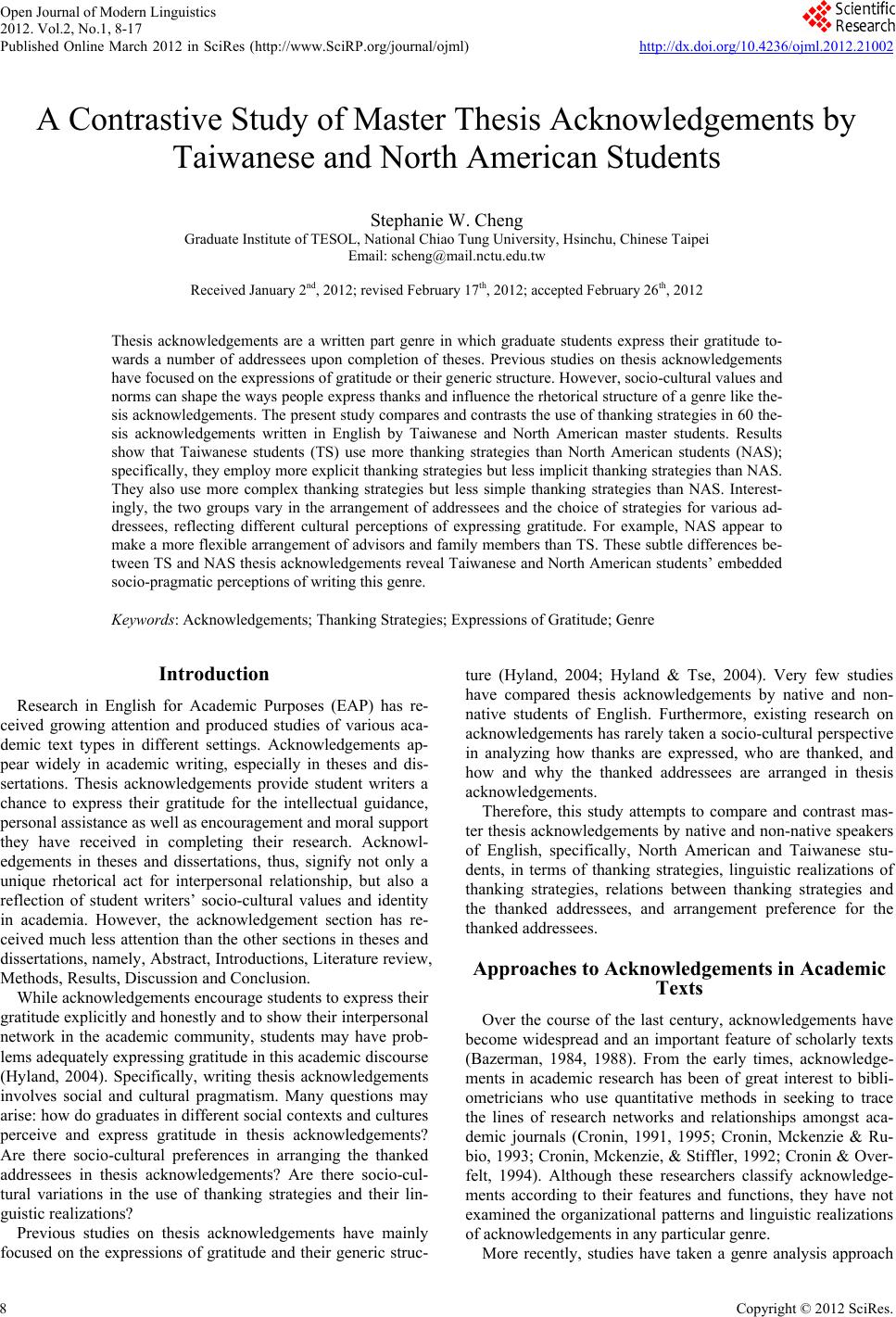 Open Journal of Modern Linguistics 2012. Vol.2, No.1, 8-17 Published Online March 2012 in SciRes (http://www.SciRP.org/journal/ojml) http://dx.doi.org/10.4236/ojml.2012.21002 Copyright © 2012 SciRes. 8 A Contrastive Study of Master Thesis Acknowledgements by Taiwanese and North American Students Stephanie W. C hen g Graduate Institute of TESOL, National Chiao Tung University, Hsinchu, Chinese Taipei Email: scheng@mail.nc tu .edu.tw Received January 2nd, 2012; revised February 17th, 2012; accepted February 26th, 2012 Thesis acknowledgements are a written part genre in which graduate students express their gratitude to- wards a number of addressees upon completion of theses. Previous studies on thesis acknowledgements have focused on the expressions of gratitude or their generic structure. However, socio-cultural values and norms can shape the ways people express thanks and influence the rhetorical structure of a genre like the- sis acknowledgements. The present study compares and contrasts the use of thanking strategies in 60 the- sis acknowledgements written in English by Taiwanese and North American master students. Results show that Taiwanese students (TS) use more thanking strategies than North American students (NAS); specifically, they employ more explicit thanking strategies but less implicit thanking strategies than NAS. They also use more complex thanking strategies but less simple thanking strategies than NAS. Interest- ingly, the two groups vary in the arrangement of addressees and the choice of strategies for various ad- dressees, reflecting different cultural perceptions of expressing gratitude. For example, NAS appear to make a more flexible arrangement of advisors and family members than TS. These subtle differences be- tween TS and NAS thesis acknowledgements reveal Taiwanese and North American students’ embedded socio-pragmatic perceptions of writing this genre. Keywords: Acknowledgements; Thanking Strategies; Expressions of Gratitude; Genre Introduction Research in English for Academic Purposes (EAP) has re- ceived growing attention and produced studies of various aca- demic text types in different settings. Acknowledgements ap- pear widely in academic writing, especially in theses and dis- sertations. Thesis acknowledgements provide student writers a chance to express their gratitude for the intellectual guidance, personal assistance a s well as encouragement and moral support they have received in completing their research. Acknowl- edgements in theses and dissertations, thus, signify not only a unique rhetorical act for interpersonal relationship, but also a reflection of student writers’ socio-cultural values and identity in academia. However, the acknowledgement section has re- ceived much less attention than the other sections in theses and dissertations, namely, Abstract, Introductions, Literature review, Methods, Results, Discussion and Conclusion. While acknowledgements encourage students to express their gratitude explicitly and honestly and to show their interpersonal network in the academic community, students may have prob- lems adequately expressing gratitude in this academic discourse (Hyland, 2004). Specifically, writing thesis acknowledgements involves social and cultural pragmatism. Many questions may arise: how do graduates in different social contexts and cultures perceive and express gratitude in thesis acknowledgements? Are there socio-cultural preferences in arranging the thanked addressees in thesis acknowledgements? Are there socio-cul- tural variations in the use of thanking strategies and their lin- guistic realizations? Previous studies on thesis acknowledgements have mainly focused on the expressions of gratitude and their generic struc- ture (Hyland, 2004; Hyland & Tse, 2004). Very few studies have compared thesis acknowledgements by native and non- native students of English. Furthermore, existing research on acknowledgements has rarely taken a socio-cultural perspective in analyzing how thanks are expressed, who are thanked, and how and why the thanked addressees are arranged in thesis acknowledgements. Therefore, this study attempts to compare and contrast mas- ter thesis acknowledgements by native and non-native speakers of English, specifically, North American and Taiwanese stu- dents, in terms of thanking strategies, linguistic realizations of thanking strategies, relations between thanking strategies and the thanked addressees, and arrangement preference for the thanked addressees. Approaches to Acknowledgements in Academic Texts Over the course of the last century, acknowledgements have become widespread and an important feature of scholarly texts (Bazerman, 1984, 1988). From the early times, acknowledge- ments in academic research has been of great interest to bibli- ometricians who use quantitative methods in seeking to trace the lines of research networks and relationships amongst aca- demic journals (Cronin, 1991, 1995; Cronin, Mckenzie & Ru- bio, 1993; Cronin, Mckenzie, & Stiffler, 1992; Cronin & Over- felt, 1994). Although these researchers classify acknowledge- ments according to their features and functions, they have not examined the organizational patterns and linguistic realizations of acknowledgements in any particular genre. More recently, studies have taken a genre analysis approach 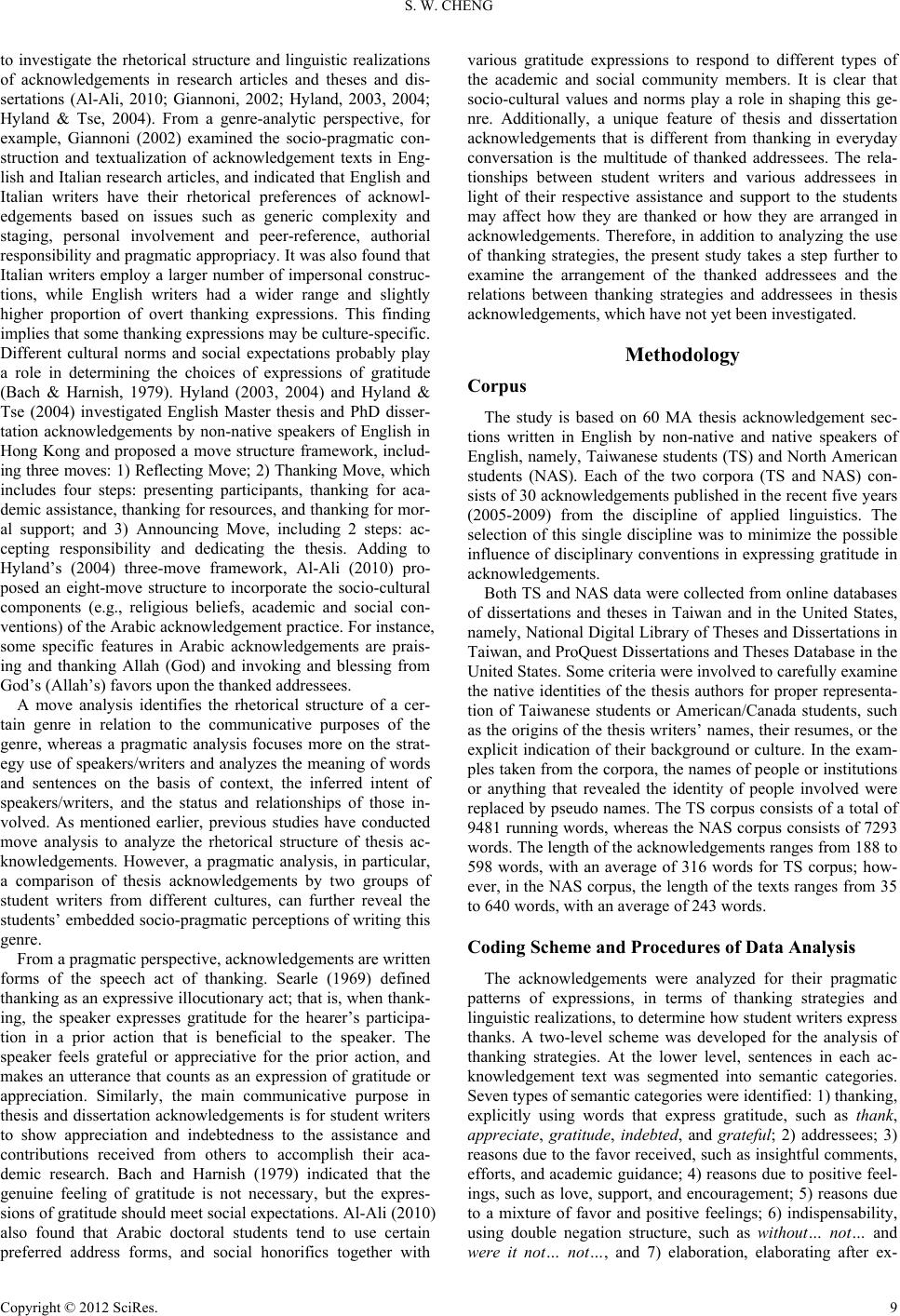 S. W. CHENG to investigate the rhetorical structure and linguistic realizations of acknowledgements in research articles and theses and dis- sertations (Al-Ali, 2010; Giannoni, 2002; Hyland, 2003, 2004; Hyland & Tse, 2004). From a genre-analytic perspective, for example, Giannoni (2002) examined the socio-pragmatic con- struction and textualization of acknowledgement texts in Eng- lish and Italian research articles, and indicated that English and Italian writers have their rhetorical preferences of acknowl- edgements based on issues such as generic complexity and staging, personal involvement and peer-reference, authorial responsibility and pragmatic appropriacy. It was also found that Italian writers employ a larger number of impersonal construc- tions, while English writers had a wider range and slightly higher proportion of overt thanking expressions. This finding implies that some thanking expressions may be culture-specific. Different cultural norms and social expectations probably play a role in determining the choices of expressions of gratitude (Bach & Harnish, 1979). Hyland (2003, 2004) and Hyland & Tse (2004) investigated English Master thesis and PhD disser- tation acknowledgements by non-native speakers of English in Hong Kong and proposed a move structure framework, includ- ing three moves: 1) Reflecting Move; 2) T hanking Move, which includes four steps: presenting participants, thanking for aca- demic assistance, thanking for resources, and thanking for mor- al support; and 3) Announcing Move, including 2 steps: ac- cepting responsibility and dedicating the thesis. Adding to Hyland’s (2004) three-move framework, Al-Ali (2010) pro- posed an eight-move structure to incorporate the socio-cultural components (e.g., religious beliefs, academic and social con- ventions) of the Arabic acknowledgement practice. For instance, some specific features in Arabic acknowledgements are prais- ing and thanking Allah (God) and invoking and blessing from God’s (Allah’s) fav o r s upon the thanked addressees. A move analysis identifies the rhetorical structure of a cer- tain genre in relation to the communicative purposes of the genre, whereas a pragmatic analysis focuses more on the strat- egy use of speakers/writers and analyzes the meaning of words and sentences on the basis of context, the inferred intent of speakers/writers, and the status and relationships of those in- volved. As mentioned earlier, previous studies have conducted move analysis to analyze the rhetorical structure of thesis ac- knowledgements. However, a pragmatic analysis, in particular, a comparison of thesis acknowledgements by two groups of student writers from different cultures, can further reveal the students’ embedded socio-pragmatic perceptions of writing this genre. From a pragmatic perspective, acknowledgements are written forms of the speech act of thanking. Searle (1969) defined thanking as an expressive illocutionary act; that is, when thank- ing, the speaker expresses gratitude for the hearer’s participa- tion in a prior action that is beneficial to the speaker. The speaker feels grateful or appreciative for the prior action, and makes an utterance that counts as an expression of gratitude or appreciation. Similarly, the main communicative purpose in thesis and dissertation acknowledgements is for student writers to show appreciation and indebtedness to the assistance and contributions received from others to accomplish their aca- demic research. Bach and Harnish (1979) indicated that the genuine feeling of gratitude is not necessary, but the expres- sions of gratitude should meet social expectations. Al-Ali (2010) also found that Arabic doctoral students tend to use certain preferred address forms, and social honorifics together with various gratitude expressions to respond to different types of the academic and social community members. It is clear that socio-cultural values and norms play a role in shaping this ge- nre. Additionally, a unique feature of thesis and dissertation acknowledgements that is different from thanking in everyday conversation is the multitude of thanked addressees. The rela- tionships between student writers and various addressees in light of their respective assistance and support to the students may affect how they are thanked or how they are arranged in acknowledgements. Therefore, in addition to analyzing the use of thanking strategies, the present study takes a step further to examine the arrangement of the thanked addressees and the relations between thanking strategies and addressees in thesis acknowledgements, which have not yet been investigated. Methodology Corpus The study is based on 60 MA thesis acknowledgement sec- tions written in English by non-native and native speakers of English, namely, Taiwanese students (TS) and North American students (NAS). Each of the two corpora (TS and NAS) con- sists of 30 acknowledgements published in the recent five years (2005-2009) from the discipline of applied linguistics. The selection of this single discipline was to minimize the possible influence of disciplinary conventions in expressing gratitude in acknowledgements. Both TS and NAS data were collected from online databases of dissertations and theses in Taiwan and in the United States, namely, National Digital Library of Theses and Dissertations in Taiwan, and ProQuest Dissertations and Theses Database in the United States. Some criteria were involved to carefully examine the native identities of the thesis authors for proper representa- tion of Taiwanese students or American/Canada students, such as the origins of the thesis writers’ names, their resumes, or the explicit indication of their background or culture. In the exam- ples taken from the corpora, the names of people or institutions or anything that revealed the identity of people involved were replaced by pseudo names. The TS corpus consists of a total of 9481 running words, whereas the NAS corpus consists of 7293 words. The length of the acknowledgements ranges from 188 to 598 words, with an average of 316 words for TS corpus; how- ever, in the NAS corpus, the length of the texts ranges from 35 to 640 words, with an average of 243 words. Coding Scheme and Procedures of Data Analysis The acknowledgements were analyzed for their pragmatic patterns of expressions, in terms of thanking strategies and linguistic realizations, to determine how student writers express thanks. A two-level scheme was developed for the analysis of thanking strategies. At the lower level, sentences in each ac- knowledgement text was segmented into semantic categories. Seven types of semantic categories were identified: 1) thanking, explicitly using words that express gratitude, such as thank, appreciate, gratitude, indebted, and grateful; 2) addressees; 3) reasons due to the favor received, such as insightful comments, efforts, and academic guidance; 4) reasons due to positive feel- ings, such as love, support, and encouragement; 5) reasons due to a mixture of favor and positive feelings; 6) indispensability, using double negation structure, such as without… not… and were it not… not…, and 7) elaboration, elaborating after ex- Copyright © 2012 SciRes. 9 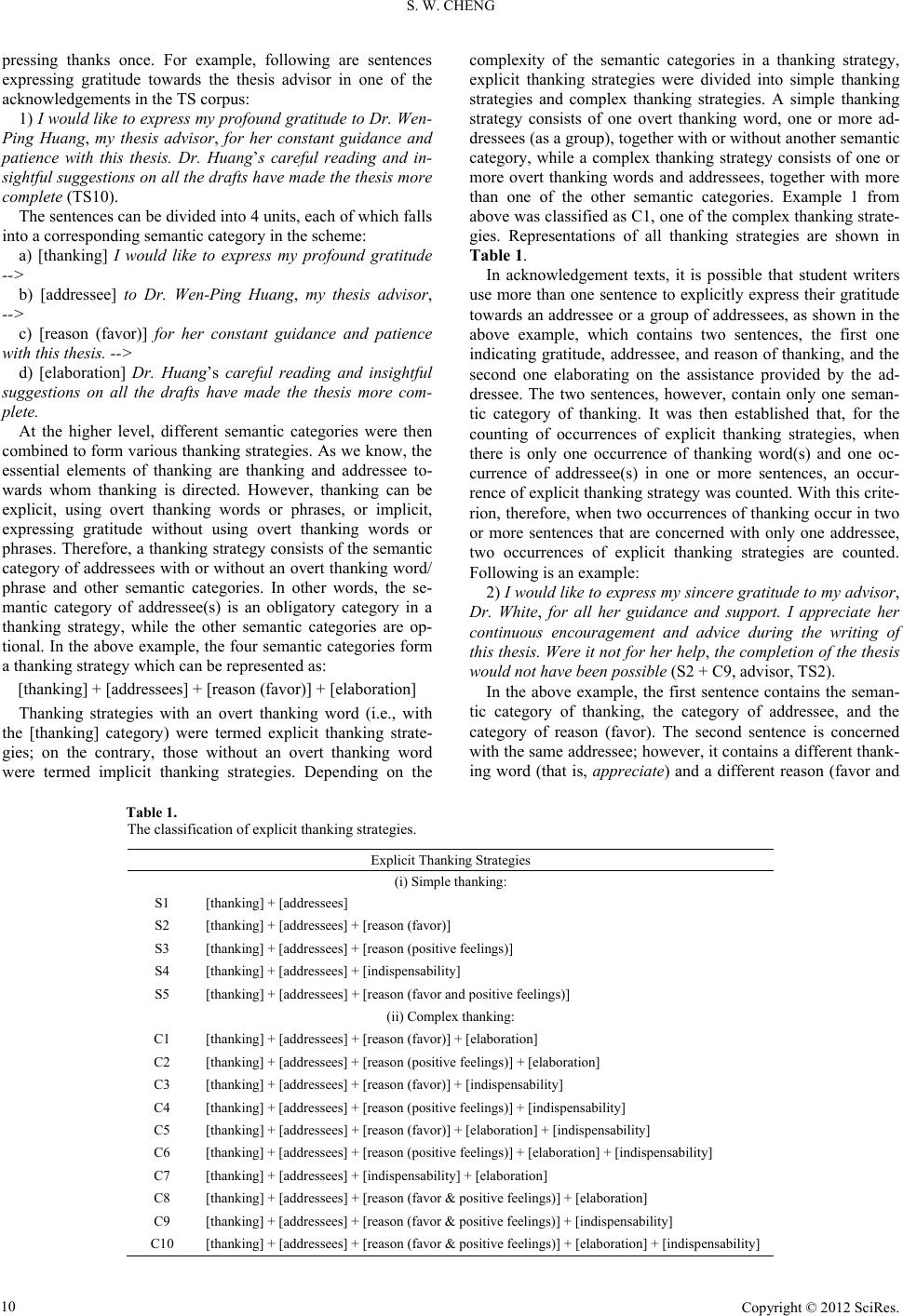 S. W. CHENG Copyright © 2012 SciRes. 10 pressing thanks once. For example, following are sentences expressing gratitude towards the thesis advisor in one of the acknowledgements in the TS corpus: 1) I would like to express my profound gratitude to Dr. Wen- Ping Huang, my thesis advisor, for her constant guidance and patience with this thesis. Dr. Huang’s careful reading and in- sightful suggestions on all the drafts have made the thesis more complete (TS10). The sentences can be divided into 4 units, each of which falls into a correspon d in g semant i c c at e g ory in the scheme: a) [thanking] I would like to express my profound gratitude --> b) [addressee] to Dr. Wen-Ping Huang, my thesis advisor, --> c) [reason (favor)] for her constant guidance and patience with this thesis. --> d) [elaboration] Dr. Huang’s careful reading and insightful suggestions on all the drafts have made the thesis more com- plete. At the higher level, different semantic categories were then combined to form various thanking strategies. As we know, the essential elements of thanking are thanking and addressee to- wards whom thanking is directed. However, thanking can be explicit, using overt thanking words or phrases, or implicit, expressing gratitude without using overt thanking words or phrases. Therefore, a thanking strategy consists of the semantic category of addressees with or without an overt thanking word/ phrase and other semantic categories. In other words, the se- mantic category of addressee(s) is an obligatory category in a thanking strategy, while the other semantic categories are op- tional. In the above example, the four semantic categories form a thanking strategy which can be represented as: [thanking] + [addressees] + [reason (favor)] + [elaboration] Thanking strategies with an overt thanking word (i.e., with the [thanking] category) were termed explicit thanking strate- gies; on the contrary, those without an overt thanking word were termed implicit thanking strategies. Depending on the complexity of the semantic categories in a thanking strategy, explicit thanking strategies were divided into simple thanking strategies and complex thanking strategies. A simple thanking strategy consists of one overt thanking word, one or more ad- dressees (as a group), together with or without another semantic category, while a complex thanking strategy consists of one or more overt thanking words and addressees, together with more than one of the other semantic categories. Example 1 from above was classified as C1, one of the complex thanking strate- gies. Representations of all thanking strategies are shown in Table 1. In acknowledgement texts, it is possible that student writers use more than one sentence to explicitly express their gratitude towards an addressee or a group of addressees, as shown in the above example, which contains two sentences, the first one indicating gratitude, addressee, and reason of thanking, and the second one elaborating on the assistance provided by the ad- dressee. The two sentences, however, contain only one seman- tic category of thanking. It was then established that, for the counting of occurrences of explicit thanking strategies, when there is only one occurrence of thanking word(s) and one oc- currence of addressee(s) in one or more sentences, an occur- rence of explicit thanking strategy was counted. With this crite- rion, therefore, when two occurrences of thanking occur in two or more sentences that are concerned with only one addressee, two occurrences of explicit thanking strategies are counted. Following is an example: 2) I would like to express my sincere gratitude to my advisor, Dr. White, for all her guidance and support. I appreciate her continuous encouragement and advice during the writing of this thesis. Were it not for her help, the completion of the thesis would not have been possible (S2 + C9, advisor, TS2). In the above example, the first sentence contains the seman- tic category of thanking, the category of addressee, and the category of reason (favor). The second sentence is concerned with the same addressee; however, it contains a different thank- ing word (that is, appreciate) and a different reason (favor and Table 1. The classification of explicit thanking strategies. Explicit Thanking S tr ategies (i) Simple thanking: S1 [thanking] + [addressees] S2 [thanking] + [addressees] + [reason (fav or)] S3 [thanking] + [addressee s] + [reason (positive feelin gs)] S4 [thanking] + [addressees] + [indispensa bility] S5 [thanking] + [addressees] + [reason (favor and positi ve feelings)] (ii) Complex thanking: C1 [thanking] + [addressees] + [reason (favor)] + [elaboration] C2 [thanking] + [addr essees] + [reason (positive feelings)] + [elaboration] C3 [thanking] + [addr essees] + [reason (favor)] + [indispensability] C4 [thanking] + [a ddr essees] + [reason (positive feelings)] + [indispensability] C5 [than king] + [addre ssees] + [rea s on (favor)] + [e laboration] + [indispensability] C6 [thanking] + [a ddr essees] + [reason (positive feelings)] + [elaboration] + [indispensability] C7 [thanking] + [addr essees] + [indispensability ] + [elaboration] C8 [than king] + [addre ssees] + [rea s on (favor & positiv e feelings)] + [elaboration] C9 [thanking] + [addressees] + [reason (favor & positive feelings)] + [indispensability] C10 [thanking] + [addressees] + [reason (fav or & positive fe elings)] + [e l aboration] + [indispensability] 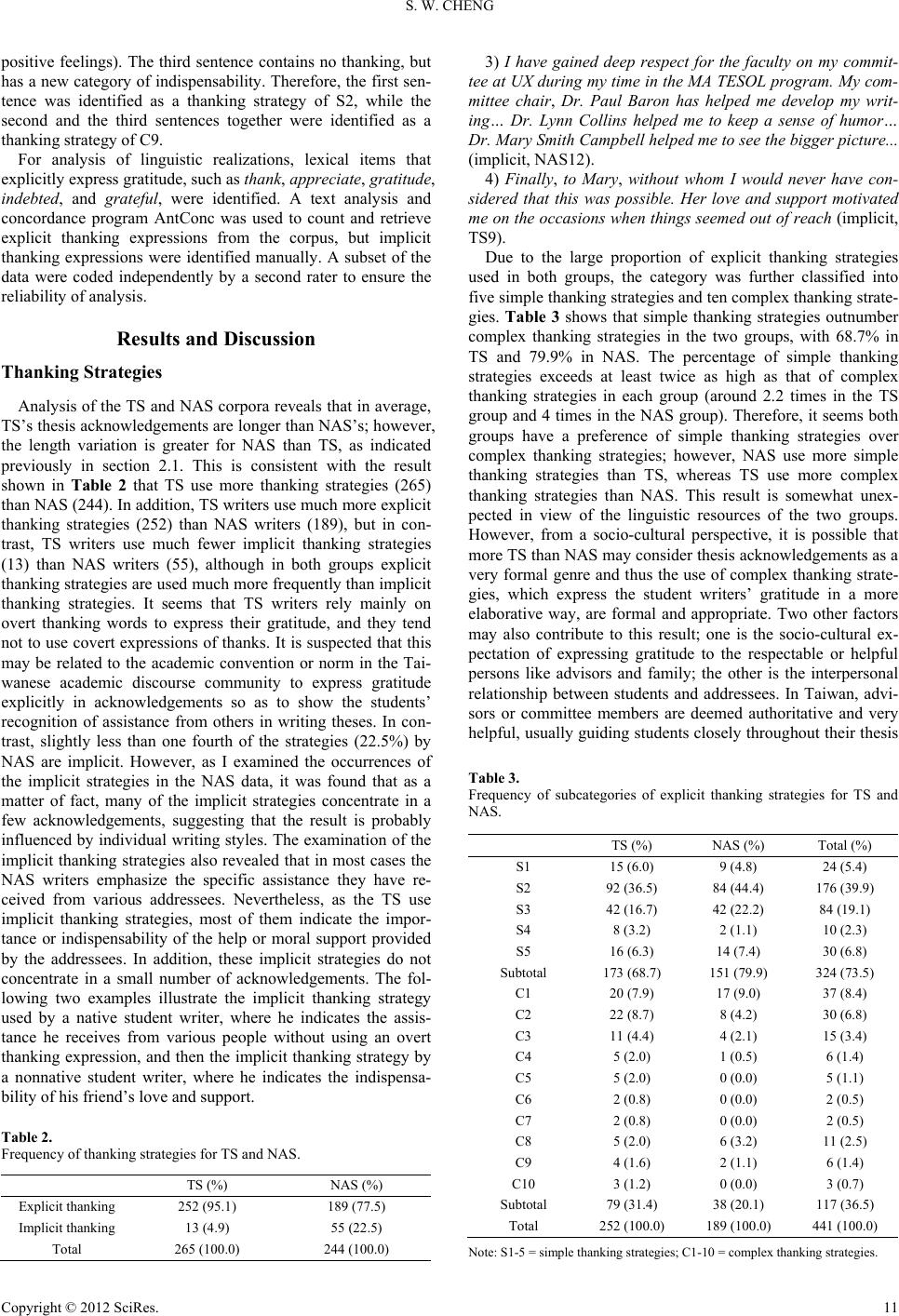 S. W. CHENG positive feelings). The third sentence contains no thanking, but has a new category of indispensability. Therefore, the first sen- tence was identified as a thanking strategy of S2, while the second and the third sentences together were identified as a thanking strategy of C9. For analysis of linguistic realizations, lexical items that explicitly express gratitude, such as thank, appreciate, gratitude, indebted, and grateful, were identified. A text analysis and concordance program AntConc was used to count and retrieve explicit thanking expressions from the corpus, but implicit thanking expressions were identified manually. A subset of the data were coded independently by a second rater to ensure the reliability of analysis. Results and Discussion Thanking Strat egies Analysis of the TS and NAS corpora reveals that in average, TS’s thesis acknowledgements are longer than NAS’s; however, the length variation is greater for NAS than TS, as indicated previously in section 2.1. This is consistent with the result shown in Table 2 that TS use more thanking strategies (265) than NAS (244). In addition, TS writers use much more explicit thanking strategies (252) than NAS writers (189), but in con- trast, TS writers use much fewer implicit thanking strategies (13) than NAS writers (55), although in both groups explicit thanking strategies are used much more frequently than implicit thanking strategies. It seems that TS writers rely mainly on overt thanking words to express their gratitude, and they tend not to use covert expressions of thanks. It is suspected that this may be related to the academic convention or norm in the Tai- wanese academic discourse community to express gratitude explicitly in acknowledgements so as to show the students’ recognition of assistance from others in writing theses. In con- trast, slightly less than one fourth of the strategies (22.5%) by NAS are implicit. However, as I examined the occurrences of the implicit strategies in the NAS data, it was found that as a matter of fact, many of the implicit strategies concentrate in a few acknowledgements, suggesting that the result is probably influenced by individual writing styles. The examination of the implicit thanking strategies also revealed that in most cases the NAS writers emphasize the specific assistance they have re- ceived from various addressees. Nevertheless, as the TS use implicit thanking strategies, most of them indicate the impor- tance or indispensability of the help or moral support provided by the addressees. In addition, these implicit strategies do not concentrate in a small number of acknowledgements. The fol- lowing two examples illustrate the implicit thanking strategy used by a native student writer, where he indicates the assis- tance he receives from various people without using an overt thanking expression, and then the implicit thanking strategy by a nonnative student writer, where he indicates the indispensa- bility of his friend’s love and support. Table 2. Frequency of thanking strategies for TS and NAS. TS (%) NAS (%) Explicit thank ing 252 (95.1) 189 (77.5) Implicit thanking 13 (4.9) 55 (22.5) Total 265 (100.0) 244 (100.0) 3) I have gained deep respect for the faculty on my commit- tee at UX during my time in the MA TESOL program. My com- mittee chair, Dr. Paul Baron has helped me develop my writ- ing… Dr. Lynn Collins helped me to keep a sense of humor… Dr. Mary Smith Campbell helped me to see the bigger picture... (implicit, NAS12). 4) Finally, to Mary, without whom I would never have con- sidered that this was possible. Her love and support motivated me on the occasions when things seemed out of reach (implicit, TS9). Due to the large proportion of explicit thanking strategies used in both groups, the category was further classified into five simple thanking strategies and ten complex thanking strate- gies. Table 3 shows that simple thanking strategies outnumber complex thanking strategies in the two groups, with 68.7% in TS and 79.9% in NAS. The percentage of simple thanking strategies exceeds at least twice as high as that of complex thanking strategies in each group (around 2.2 times in the TS group and 4 times in the NAS group). Therefore, it seems both groups have a preference of simple thanking strategies over complex thanking strategies; however, NAS use more simple thanking strategies than TS, whereas TS use more complex thanking strategies than NAS. This result is somewhat unex- pected in view of the linguistic resources of the two groups. However, from a socio-cultural perspective, it is possible that more TS than NAS may consider thesis acknowledgements as a very formal genre and thus the use of complex thanking strate- gies, which express the student writers’ gratitude in a more elaborative way, are formal and appropriate. Two other factors may also contribute to this result; one is the socio-cultural ex- pectation of expressing gratitude to the respectable or helpful persons like advisors and family; the other is the interpersonal relationship between students and addressees. In Taiwan, advi- sors or committee members are deemed authoritative and very helpful, usually guiding students closely throughout their thesis Table 3. Frequency of subcategories of explicit thanking strategies for TS and NAS. TS (%) NAS (%) Total (%) S1 15 (6.0) 9 (4.8) 24 (5.4) S2 92 (36.5) 84 (44.4) 176 (39.9) S3 42 (16.7) 42 (22.2) 84 (19.1) S4 8 (3.2) 2 (1.1) 10 (2.3) S5 16 (6.3) 14 ( 7.4) 30 (6.8) Subtotal 173 (68.7) 151 (79.9) 324 (73.5) C1 20 (7.9) 17 (9.0) 37 (8.4) C2 22 (8.7) 8 (4.2) 30 (6.8) C3 11 (4.4) 4 (2.1) 15 (3.4) C4 5 (2.0) 1 (0.5 ) 6 (1.4) C5 5 (2.0) 0 (0.0) 5 (1.1) C6 2 (0.8) 0 (0.0) 2 (0.5) C7 2 (0.8) 0 (0.0) 2 (0.5) C8 5 (2.0) 6 (3.2) 11 (2.5) C9 4 (1.6) 2 (1.1) 6 (1.4) C10 3 (1.2) 0 (0.0) 3 (0.7) Subtotal 79 (31.4) 38 (20.1) 117 (36.5) Total 252 (100.0 ) 189 (100.0 ) 441 (100.0 ) Note: S1-5 = simple thanking strategies; C1-10 = complex thanking strateg ies. Copyright © 2012 SciRes. 11 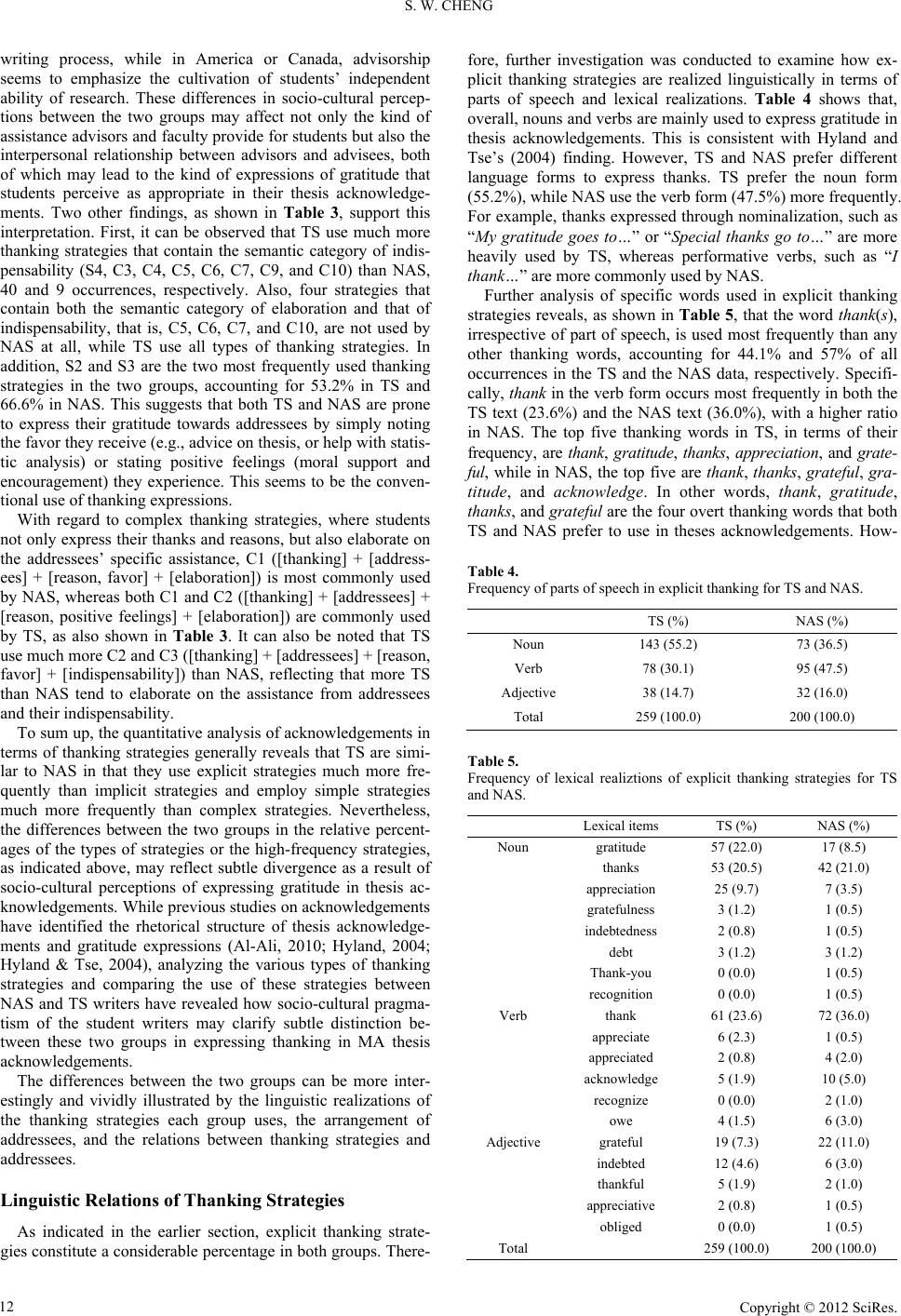 S. W. CHENG writing process, while in America or Canada, advisorship seems to emphasize the cultivation of students’ independent ability of research. These differences in socio-cultural percep- tions between the two groups may affect not only the kind of assistance advisors and faculty provide for students but also the interpersonal relationship between advisors and advisees, both of which may lead to the kind of expressions of gratitude that students perceive as appropriate in their thesis acknowledge- ments. Two other findings, as shown in Table 3, support this interpretation. First, it can be observed that TS use much more thanking strategies that contain the semantic category of indis- pensability (S4, C3, C4, C5, C6, C7, C9, and C10) than NAS, 40 and 9 occurrences, respectively. Also, four strategies that contain both the semantic category of elaboration and that of indispensability, that is, C5, C6, C7, and C10, are not used by NAS at all, while TS use all types of thanking strategies. In addition, S2 and S3 are the two most frequently used thanking strategies in the two groups, accounting for 53.2% in TS and 66.6% in NAS. This suggests that both TS and NAS are prone to express their gratitude towards addressees by simply noting the favor they receive (e.g., advice on thesis, or help with statis- tic analysis) or stating positive feelings (moral support and encouragement) they experience. This seems to be the conven- tional use of thanking expressions. With regard to complex thanking strategies, where students not only express their thanks and reasons, but also elaborate on the addressees’ specific assistance, C1 ([thanking] + [address- ees] + [reason, favor] + [elaboration]) is most commonly used by NAS, whereas both C1 and C2 ([thanking] + [addressees] + [reason, positive feelings] + [elaboration]) are commonly used by TS, as also shown in Table 3. It can also be noted that TS use much more C2 and C3 ([thanking] + [addressees] + [reason, favor] + [indispensability]) than NAS, reflecting that more TS than NAS tend to elaborate on the assistance from addressees and their indispensability. To sum up, the quantitative analysis of acknowledgements in terms of thanking strategies generally reveals that TS are simi- lar to NAS in that they use explicit strategies much more fre- quently than implicit strategies and employ simple strategies much more frequently than complex strategies. Nevertheless, the differences between the two groups in the relative percent- ages of the types of strategies or the high-frequency strategies, as indicated above, may reflect subtle divergence as a result of socio-cultural perceptions of expressing gratitude in thesis ac- knowledgements. While previous studies on acknowledgements have identified the rhetorical structure of thesis acknowledge- ments and gratitude expressions (Al-Ali, 2010; Hyland, 2004; Hyland & Tse, 2004), analyzing the various types of thanking strategies and comparing the use of these strategies between NAS and TS writers have revealed how socio-cultural pragma- tism of the student writers may clarify subtle distinction be- tween these two groups in expressing thanking in MA thesis acknowledgements. The differences between the two groups can be more inter- estingly and vividly illustrated by the linguistic realizations of the thanking strategies each group uses, the arrangement of addressees, and the relations between thanking strategies and addressees. Linguistic Rel ations of Thanking Strategies As indicated in the earlier section, explicit thanking strate- gies constitute a considerable percentage in both groups. There- fore, further investigation was conducted to examine how ex- plicit thanking strategies are realized linguistically in terms of parts of speech and lexical realizations. Table 4 shows that, overall, nouns and verbs are mainly used to express gratitude in thesis acknowledgements. This is consistent with Hyland and Tse’s (2004) finding. However, TS and NAS prefer different language forms to express thanks. TS prefer the noun form (55.2%), while NAS use the verb form (47.5%) more frequently. For example, thanks expressed through nominalization, such as “My gratitude goes to…” or “Special thanks go to…” are more heavily used by TS, whereas performative verbs, such as “I thank…” are more commonly used by NAS. Further analysis of specific words used in explicit thanking strategies reveals, as shown in Table 5, that the word thank(s), irrespective of part of speech, is used most frequently than any other thanking words, accounting for 44.1% and 57% of all occurrences in the TS and the NAS data, respectively. Specifi- cally, thank in the verb form occurs most frequently in both the TS text (23.6%) and the NAS text (36.0%), with a higher ratio in NAS. The top five thanking words in TS, in terms of their frequency, are thank, gratitude, thanks, appreciation, and grate- ful, while in NAS, the top five are thank, thanks, grateful, gra- titude, and acknowledge. In other words, thank, gratitude, thanks, and grateful are the four overt thanking words that both TS and NAS prefer to use in theses acknowledgements. How- Table 4. Frequency of parts of speech in explicit thanking for TS and NAS. TS (%) NAS (%) Noun 143 (55.2) 73 (36.5) Verb 78 (30.1) 95 (4 7.5) Adjective 38 (14.7) 32 (16.0) Total 259 (100.0) 200 (100.0) Table 5. Frequency of lexical realiztions of explicit thanking strategies for TS and NAS. Lexical items TS (%) NAS (%) Noun gratitude 57 (22.0) 17 (8.5) thanks 53 (20.5) 42 (21.0) apprecia tio n 25 (9.7) 7 (3.5) gratefulness 3 (1.2) 1 (0.5) indebtedness 2 (0.8) 1 (0.5) debt 3 (1.2) 3 (1.2) Thank-you 0 (0.0) 1 (0.5) recognition 0 (0.0) 1 (0.5) Verb thank 61 (23.6) 72 (36.0) appreciate 6 (2.3) 1 (0.5) appreciated 2 (0.8) 4 (2.0) acknowledge 5 (1.9) 10 (5.0) recognize 0 (0.0) 2 (1.0) owe 4 (1.5) 6 (3.0) Adjective grateful 19 (7.3) 22 (11.0) indebted 12 (4.6) 6 (3.0) thankful 5 (1.9) 2 (1.0) appreciative 2 (0.8) 1 (0.5) obliged 0 (0.0) 1 (0.5) Total 259 (100.0) 200 (100.0) Copyright © 2012 SciRes. 12 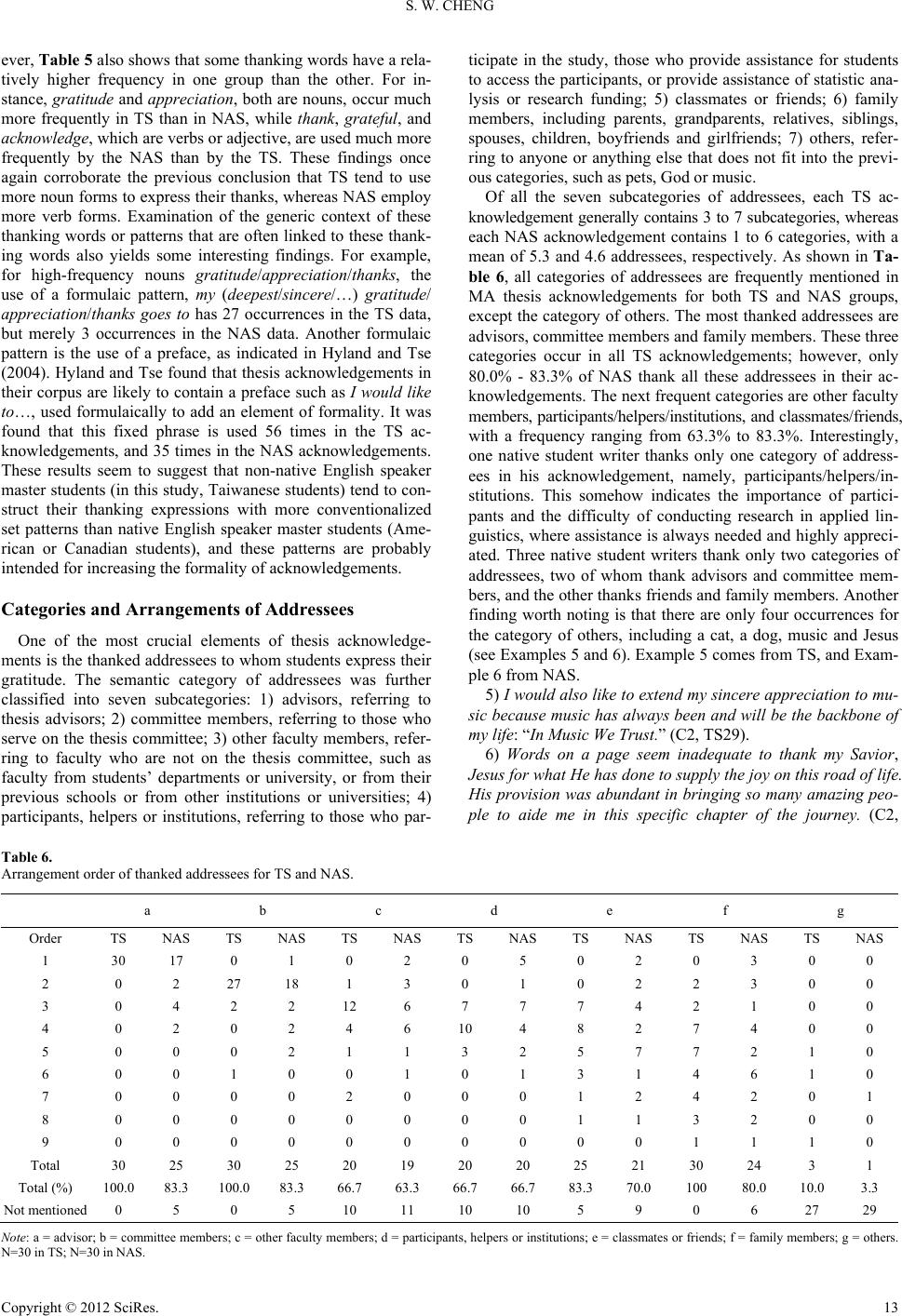 S. W. CHENG Copyright © 2012 SciRes. 13 ever, Table 5 also shows that some thanking words have a rela- tively higher frequency in one group than the other. For in- stance, gratitude and appreciation, both are nouns, occur much more frequently in TS than in NAS, while thank, grateful, and acknowledge, which are verbs or adjective, are used much more frequently by the NAS than by the TS. These findings once again corroborate the previous conclusion that TS tend to use more noun forms to express their thanks, whereas NAS employ more verb forms. Examination of the generic context of these thanking words or patterns that are often linked to these thank- ing words also yields some interesting findings. For example, for high-frequency nouns gratitude/appreciation/thanks, the use of a formulaic pattern, my (deepest/sincere/…) gratitude/ appreciation/thanks goes to has 27 occurrences in the TS data, but merely 3 occurrences in the NAS data. Another formulaic pattern is the use of a preface, as indicated in Hyland and Tse (2004). Hyland and Tse found that thesis acknowledgements in their corpus are likely to contain a preface such as I would like to…, used formulaically to add an element of formality. It was found that this fixed phrase is used 56 times in the TS ac- knowledgements, and 35 times in the NAS acknowledgements. These results seem to suggest that non-native English speaker master students (in this study, Taiwanese students) tend to con- struct their thanking expressions with more conventionalized set patterns than native English speaker master students (Ame- rican or Canadian students), and these patterns are probably intended for increasing the formality of acknowledgements. Categories an d Arrangements o f Add re ssees One of the most crucial elements of thesis acknowledge- ments is the thanked addressees to whom students express their gratitude. The semantic category of addressees was further classified into seven subcategories: 1) advisors, referring to thesis advisors; 2) committee members, referring to those who serve on the thesis committee; 3) other faculty members, refer- ring to faculty who are not on the thesis committee, such as faculty from students’ departments or university, or from their previous schools or from other institutions or universities; 4) participants, helpers or institutions, referring to those who par- ticipate in the study, those who provide assistance for students to access the participants, or provide assistance of statistic ana- lysis or research funding; 5) classmates or friends; 6) family members, including parents, grandparents, relatives, siblings, spouses, children, boyfriends and girlfriends; 7) others, refer- ring to anyone or anything else that does not fit into the previ- ous categories, such as pets, God or music. Of all the seven subcategories of addressees, each TS ac- knowledgement generally contains 3 to 7 subcategories, whereas each NAS acknowledgement contains 1 to 6 categories, with a mean of 5.3 and 4.6 addressees, respectively. As shown in Ta- ble 6, all categories of addressees are frequently mentioned in MA thesis acknowledgements for both TS and NAS groups, except the category of others. The most thanked addressees are advisors, committee members and family members. These three categories occur in all TS acknowledgements; however, only 80.0% - 83.3% of NAS thank all these addressees in their ac- knowledgements. The next frequent categories are other faculty members, participants/helpers/institutions, and classmates/friends, with a frequency ranging from 63.3% to 83.3%. Interestingly, one native student writer thanks only one category of address- ees in his acknowledgement, namely, participants/helpers/in- stitutions. This somehow indicates the importance of partici- pants and the difficulty of conducting research in applied lin- guistics, where assistance is always needed and highly appreci- ated. Three native student writers thank only two categories of addressees, two of whom thank advisors and committee mem- bers, and the other thanks friends and family members. Another finding worth noting is that there are only four occurrences for the category of others, including a cat, a dog, music and Jesus (see Examples 5 and 6). Example 5 comes from TS, and Exam- ple 6 from NAS. 5) I would also like to extend my sincere appreciation to mu- sic because music has always been and will be the backbone of my life: “In Music We Trust.” (C2, TS29). 6) Words on a page seem inadequate to thank my Savior, Jesus for what He has done to supply the joy on this road of life. His provision was abundant in bringing so many amazing peo- ple to aide me in this specific chapter of the journey. (C2, Table 6. Arrangem ent order of thanked addressees for TS and NAS. a b c d e f g Order TS NAS TS NAS TS NAS TS NAS TS NAS TS NAS TS NAS 1 30 17 0 1 0 2 0 5 0 2 0 3 0 0 2 0 2 27 18 1 3 0 1 0 2 2 3 0 0 3 0 4 2 2 12 6 7 7 7 4 2 1 0 0 4 0 2 0 2 4 6 10 4 8 2 7 4 0 0 5 0 0 0 2 1 1 3 2 5 7 7 2 1 0 6 0 0 1 0 0 1 0 1 3 1 4 6 1 0 7 0 0 0 0 2 0 0 0 1 2 4 2 0 1 8 0 0 0 0 0 0 0 0 1 1 3 2 0 0 9 0 0 0 0 0 0 0 0 0 0 1 1 1 0 Total 30 25 30 25 20 19 20 20 25 21 30 24 3 1 Total (%) 100.0 83.3 100.0 83.3 66.7 63.3 66.7 66.7 83.3 70.0 100 80.0 10.0 3.3 Not mentioned 0 5 0 5 10 11 10 10 5 9 0 6 27 29 Note: a = advisor; b = committee members; c = other faculty members; d = participants, helpers o r institution s; e = classmates or friends; f = family members; g = others. =30 in TS; N=30 in NAS. N 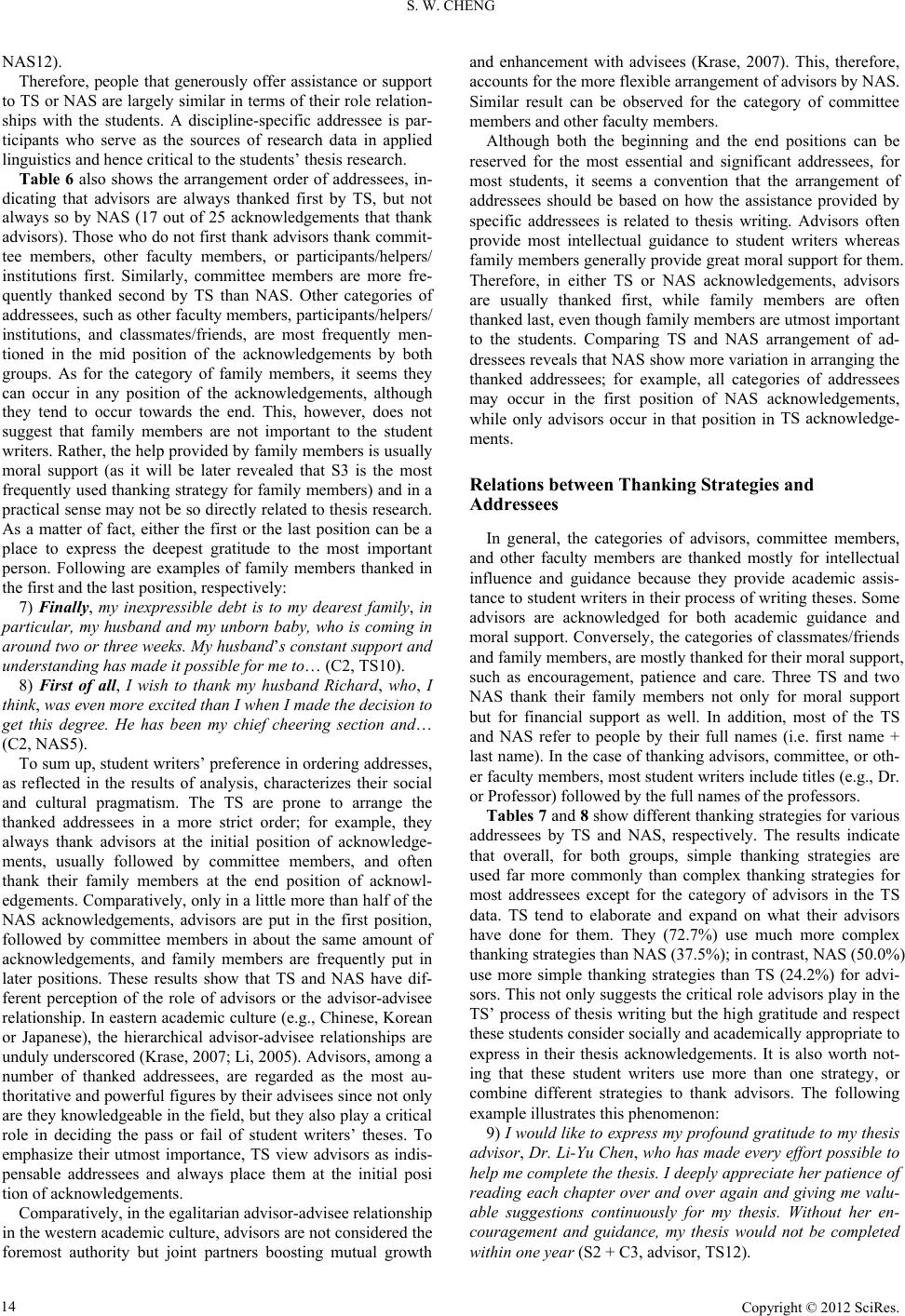 S. W. CHENG NAS12). Therefore, people that generously offer assistance or support to TS or NAS are largely similar in terms of their role relation- ships with the students. A discipline-specific addressee is par- ticipants who serve as the sources of research data in applied linguistics and hence critical to the students’ thesis research. Table 6 also shows the arrangement order of addressees, in- dicating that advisors are always thanked first by TS, but not always so by NAS (17 out of 25 acknowledgements that thank advisors). Those who do not first thank advisors thank commit- tee members, other faculty members, or participants/helpers/ institutions first. Similarly, committee members are more fre- quently thanked second by TS than NAS. Other categories of addressees, such as other faculty members, participants/helpers/ institutions, and classmates/friends, are most frequently men- tioned in the mid position of the acknowledgements by both groups. As for the category of family members, it seems they can occur in any position of the acknowledgements, although they tend to occur towards the end. This, however, does not suggest that family members are not important to the student writers. Rather, the help provided by family members is usually moral support (as it will be later revealed that S3 is the most frequently used thanking strategy for family members) and in a practical sense may not be so directly related to thesis research. As a matter of fact, either the first or the last position can be a place to express the deepest gratitude to the most important person. Following are examples of family members thanked in the first and the last position, respectively: 7) Finally, my inexpressible debt is to my dearest family, in particular, my husband and my unborn baby, who is coming in around two or three weeks. My husband’s constant support and understanding has made it possible for me to… (C2, TS10). 8) First of all, I wish to thank my husband Richard, who, I think, was even more excited than I when I made the decision to get this degree. He has been my chief cheering section and… (C2, NAS5). To sum up, student writers’ preference in ordering addresses, as reflected in the results of analysis, characterizes their social and cultural pragmatism. The TS are prone to arrange the thanked addressees in a more strict order; for example, they always thank advisors at the initial position of acknowledge- ments, usually followed by committee members, and often thank their family members at the end position of acknowl- edgements. Comparatively, only in a little more than half of the NAS acknowledgements, advisors are put in the first position, followed by committee members in about the same amount of acknowledgements, and family members are frequently put in later positions. These results show that TS and NAS have dif- ferent perception of the role of advisors or the advisor-advisee relationship. In eastern academic culture (e.g., Chinese, Korean or Japanese), the hierarchical advisor-advisee relationships are unduly underscored (Krase, 2007; Li, 2005). Advisors, among a number of thanked addressees, are regarded as the most au- thoritative and powerful figures by their advisees since not only are they knowledgeable in the field, but they also play a critical role in deciding the pass or fail of student writers’ theses. To emphasize their utmost importance, TS view advisors as indis- pensable addressees and always place them at the initial posi tion of acknowledgements. Comparatively, in the egalitarian a d v i s or - a d v i s e e r e l a t i o ns h i p in the western academic culture, advisors are not considered the foremost authority but joint partners boosting mutual growth and enhancement with advisees (Krase, 2007). This, therefore, accounts for the more flexible arrangement of advisors by NAS. Similar result can be observed for the category of committee members and other facu lty members. Although both the beginning and the end positions can be reserved for the most essential and significant addressees, for most students, it seems a convention that the arrangement of addressees should be based on how the assistance provided by specific addressees is related to thesis writing. Advisors often provide most intellectual guidance to student writers whereas family members generally provide great moral support for them. Therefore, in either TS or NAS acknowledgements, advisors are usually thanked first, while family members are often thanked last, even though family members are utmost important to the students. Comparing TS and NAS arrangement of ad- dressees reveals that NAS show more variation in arranging the thanked addressees; for example, all categories of addressees may occur in the first position of NAS acknowledgements, while only advisors occur in that position in TS acknowledge- ments. Relations between Thanking Strategies and Addressees In general, the categories of advisors, committee members, and other faculty members are thanked mostly for intellectual influence and guidance because they provide academic assis- tance to student writers in their process of writing theses. Some advisors are acknowledged for both academic guidance and moral support. Conversely, the categories of classmates/friends and family members, are mostly thanked for their moral support, such as encouragement, patience and care. Three TS and two NAS thank their family members not only for moral support but for financial support as well. In addition, most of the TS and NAS refer to people by their full names (i.e. first name + last name). In the case of thanking advisors, committee, or oth- er faculty members, most student writers include titles (e.g., Dr. or Professor) followed by the full names of the professors. Tables 7 and 8 show different thanking strategies for various addressees by TS and NAS, respectively. The results indicate that overall, for both groups, simple thanking strategies are used far more commonly than complex thanking strategies for most addressees except for the category of advisors in the TS data. TS tend to elaborate and expand on what their advisors have done for them. They (72.7%) use much more complex thanking strategies than NAS (37.5%); in contrast, NAS (50.0%) use more simple thanking strategies than TS (24.2%) for advi- sors. This not only suggests the critical role advisors play in the TS’ process of thesis writing but the high gratitude and respect these students consider socially and academically appropriate to express in their thesis acknowledgements. It is also worth not- ing that these student writers use more than one strategy, or combine different strategies to thank advisors. The following example illustrates this phenomenon: 9) I would like to express my profound gratitude to my thesis advisor, Dr. Li-Yu Chen, who has made every effort possible to help me complete the thesis. I deeply appreciate her patience of reading each chapter over and over again and giving me valu- able suggestions continuously for my thesis. Without her en- couragement and guidance, my thesis would not be completed within one year (S2 + C3, advisor, TS12). Copyright © 2012 SciRes. 14 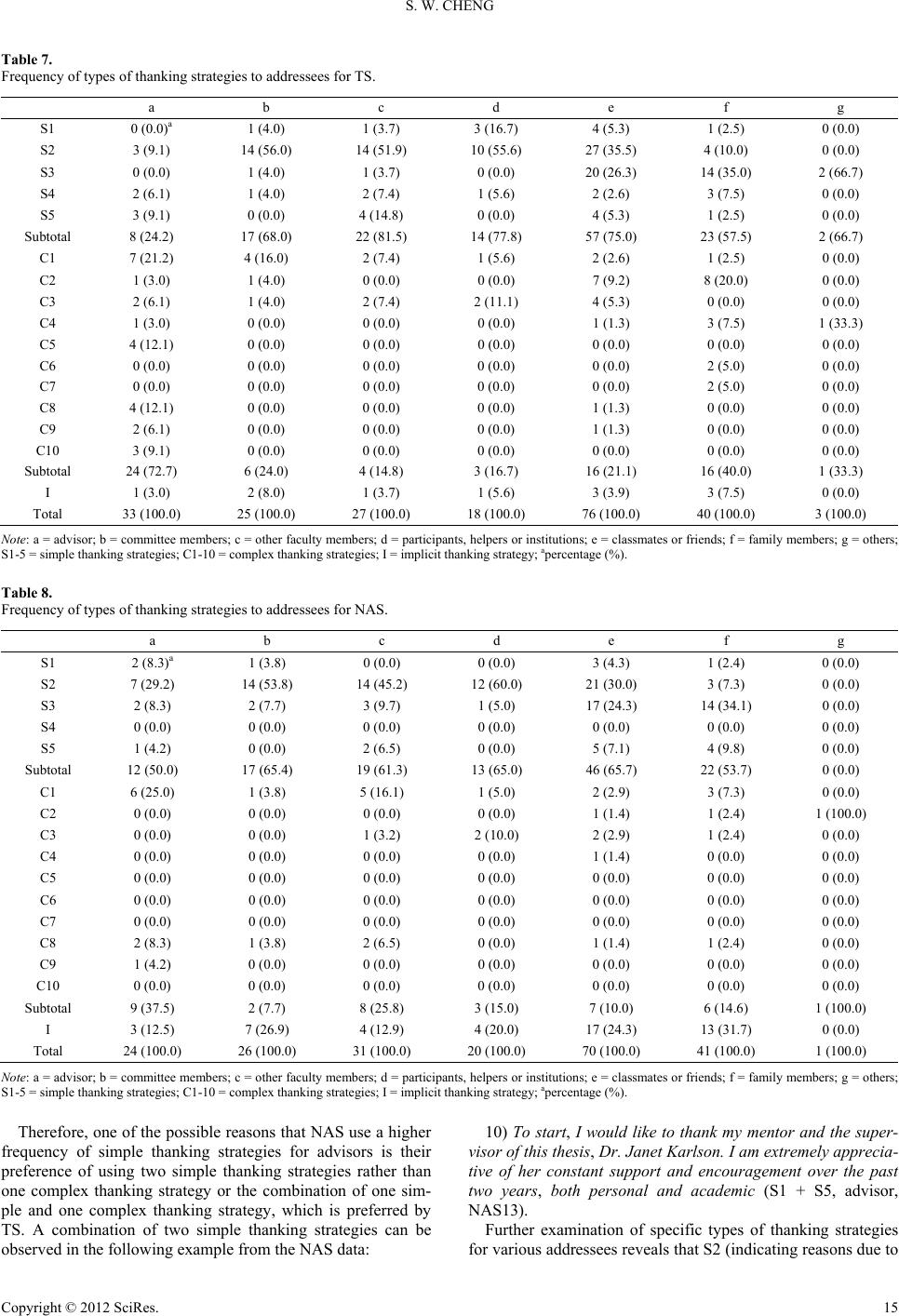 S. W. CHENG Table 7. Frequency of types of thanking strategies to addressees for TS. a b c d e f g S1 0 (0.0)a 1 (4.0) 1 (3.7) 3 (16.7) 4 (5.3) 1 (2.5) 0 (0.0) S2 3 (9.1) 14 (56.0) 14 (51.9) 10 (55.6) 27 (35.5) 4 (10.0) 0 (0.0) S3 0 (0.0) 1 (4.0) 1 (3.7) 0 (0.0) 20 (26.3) 14 (35.0) 2 (66.7) S4 2 (6.1) 1 (4.0) 2 (7.4) 1 (5.6) 2 (2.6) 3 (7.5) 0 (0.0) S5 3 (9.1) 0 (0.0) 4 (14.8) 0 (0.0) 4 (5.3) 1 (2.5) 0 (0.0) Subtotal 8 (2 4.2) 17 (68.0) 22 (81.5) 14 (77.8) 57 (75.0) 23 (57.5) 2 (66. 7 ) C1 7 (21.2) 4 (16.0) 2 (7.4) 1 (5.6) 2 (2.6) 1 (2.5) 0 (0.0) C2 1 (3.0) 1 (4.0) 0 (0.0) 0 (0.0) 7 (9.2) 8 (20.0) 0 (0.0) C3 2 (6.1) 1 (4.0) 2 (7.4) 2 (11.1) 4 (5.3) 0 (0.0) 0 (0.0) C4 1 (3.0) 0 (0.0) 0 (0.0) 0 (0.0) 1 (1.3) 3 (7.5) 1 (33.3) C5 4 (12.1) 0 (0.0) 0 (0.0) 0 (0.0) 0 (0.0) 0 (0.0) 0 (0.0) C6 0 (0.0) 0 (0.0) 0 (0.0) 0 (0.0) 0 (0.0) 2 (5.0) 0 (0.0) C7 0 (0.0) 0 (0.0) 0 (0.0) 0 (0.0) 0 (0.0) 2 (5.0) 0 (0.0) C8 4 (12.1) 0 (0.0) 0 (0.0) 0 (0.0) 1 (1.3) 0 (0.0) 0 (0.0) C9 2 (6.1) 0 (0.0) 0 (0.0) 0 (0.0) 1 (1.3) 0 (0.0) 0 (0.0) C10 3 (9.1) 0 (0.0) 0 (0.0) 0 (0.0) 0 (0.0) 0 (0.0) 0 (0.0) Subtotal 24 (72.7) 6 (24.0) 4 (14.8) 3 (16.7) 16 (21.1) 16 (40.0) 1 (33.3) I 1 (3.0) 2 (8.0) 1 (3.7) 1 (5.6) 3 (3.9) 3 (7.5) 0 (0.0) Total 33 (100.0) 25 (100.0) 27 (100.0) 18 (100.0) 76 (100.0) 40 (100.0) 3 (10 0.0) Note: a = advisor; b = committee members; c = other faculty members; d = participants, helpers or institutions; e = classmates or friends; f = family members; g = others; S1-5 = sim ple thanking strategies; C1-10 = complex thank ing strategies; I = implicit thanking strate gy; apercentage (%). Table 8. Frequency of types of thanking strategies to addressees for NAS. a b c d e f g S1 2 (8.3)a 1 (3.8) 0 (0.0) 0 (0.0) 3 (4.3) 1 (2.4) 0 (0.0) S2 7 (29.2) 14 (53.8) 14 (45.2) 12 (60.0) 21 (30.0) 3 (7.3) 0 (0.0) S3 2 (8.3) 2 (7.7) 3 (9.7) 1 (5.0) 17 (24.3) 14 (34.1) 0 (0.0) S4 0 (0.0) 0 (0.0) 0 (0.0) 0 (0.0) 0 (0.0) 0 (0.0) 0 (0.0) S5 1 (4.2) 0 (0.0) 2 (6.5) 0 (0.0) 5 (7.1) 4 (9.8) 0 (0.0) Subtotal 12 (50.0) 17 (65.4) 19 (61.3) 13 (65.0) 46 (65.7) 22 (53.7) 0 (0.0) C1 6 (25.0) 1 (3.8) 5 (16.1) 1 (5.0) 2 (2.9) 3 (7.3) 0 (0.0) C2 0 (0.0) 0 (0.0) 0 (0.0) 0 (0.0) 1 (1.4) 1 (2.4) 1 (100.0) C3 0 (0.0) 0 (0.0) 1 (3.2) 2 (10.0) 2 (2.9) 1 (2.4) 0 (0.0) C4 0 (0.0) 0 (0.0) 0 (0.0) 0 (0.0) 1 (1.4) 0 (0.0) 0 (0.0) C5 0 (0.0) 0 (0.0) 0 (0.0) 0 (0.0) 0 (0.0) 0 (0.0) 0 (0.0) C6 0 (0.0) 0 (0.0) 0 (0.0) 0 (0.0) 0 (0.0) 0 (0.0) 0 (0.0) C7 0 (0.0) 0 (0.0) 0 (0.0) 0 (0.0) 0 (0.0) 0 (0.0) 0 (0.0) C8 2 (8.3) 1 (3.8) 2 (6.5) 0 (0.0) 1 (1.4) 1 (2.4) 0 (0.0) C9 1 (4.2) 0 (0.0) 0 (0.0) 0 (0.0) 0 (0.0) 0 (0.0) 0 (0.0) C10 0 (0.0) 0 (0.0) 0 (0.0) 0 (0.0) 0 (0.0) 0 (0.0) 0 (0.0) Subtotal 9 (37.5) 2 (7.7) 8 (25.8) 3 (15.0) 7 (10.0) 6 (14.6) 1 (100.0) I 3 (12.5) 7 (26.9) 4 (12.9) 4 (20.0) 17 (24.3) 13 (31.7) 0 (0.0) Total 24 (100.0) 26 (100.0) 31 (100.0) 20 (100.0) 70 (100.0) 41 (100.0) 1 (100.0) Note: a = advisor; b = committee members; c = other faculty members; d = participants, helpers or institutions; e = classmates or friends; f = family members; g = others; S1-5 = sim ple thanking strategies; C1-10 = complex thank ing strategies; I = implicit thanking strate gy; apercentage (%). Therefore, one of the possible reasons that NAS use a higher frequency of simple thanking strategies for advisors is their preference of using two simple thanking strategies rather than one complex thanking strategy or the combination of one sim- ple and one complex thanking strategy, which is preferred by TS. A combination of two simple thanking strategies can be observed in the following example from the NAS data: 10) To start, I would like to thank my mentor and the super- visor of this thesis, Dr. Janet Karlson. I am extremely apprecia- tive of her constant support and encouragement over the past two years, both personal and academic (S1 + S5, advisor, NAS13). Further examination of specific types of thanking strategies for various addressees reveals that S2 (indicating reasons due to Copyright © 2012 SciRes. 15 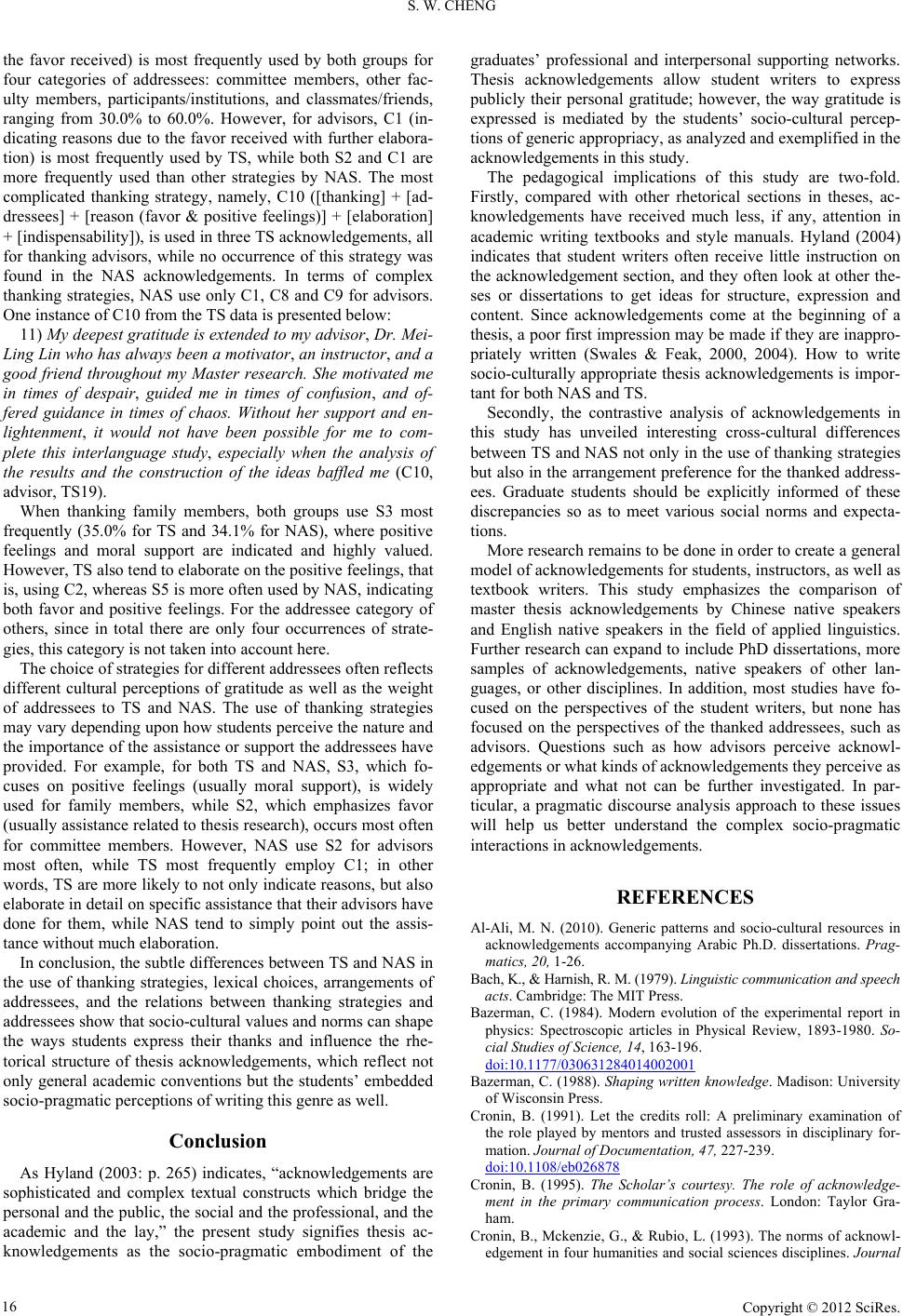 S. W. CHENG the favor received) is most frequently used by both groups for four categories of addressees: committee members, other fac- ulty members, participants/institutions, and classmates/friends, ranging from 30.0% to 60.0%. However, for advisors, C1 (in- dicating reasons due to the favor received with further elabora- tion) is most frequently used by TS, while both S2 and C1 are more frequently used than other strategies by NAS. The most complicated thanking strategy, namely, C10 ([thanking] + [ad- dressees] + [reason (favor & positive feelings)] + [elaboration] + [indispensability]), is used in three TS acknowledgeme nts, all for thanking advisors, while no occurrence of this strategy was found in the NAS acknowledgements. In terms of complex thanking strategies, NAS use only C1, C8 and C9 for advisors. One instance of C10 from the TS data is presented below: 11) My deepest gratitude is extended to my advisor, Dr. Mei- Ling Lin who has always been a motivator, an instructor, and a good friend throughout my Master research. She motivated me in times of despair, guided me in times of confusion, and of- fered guidance in times of chaos. Without her support and en- lightenment, it would not have been possible for me to com- plete this interlanguage study, especially when the analysis of the results and the construction of the ideas baffled me (C10, advisor, TS19). When thanking family members, both groups use S3 most frequently (35.0% for TS and 34.1% for NAS), where positive feelings and moral support are indicated and highly valued. However, TS also tend to elaborate on the positive feelings, that is, using C2, whereas S5 is more often used by NAS, indicating both favor and positive feelings. For the addressee category of others, since in total there are only four occurrences of strate- gies, this category is not taken into account here. The choice of strategies for different addressees often reflects different cultural perceptions of gratitude as well as the weight of addressees to TS and NAS. The use of thanking strategies may vary depending upon how students perceive the nature and the importance of the assistance or support the addressees have provided. For example, for both TS and NAS, S3, which fo- cuses on positive feelings (usually moral support), is widely used for family members, while S2, which emphasizes favor (usually assistance related to thesis research), occurs most often for committee members. However, NAS use S2 for advisors most often, while TS most frequently employ C1; in other words, TS are more likely to not only indicate reasons, but also elaborate in detail on specific assistance that their advisors have done for them, while NAS tend to simply point out the assis- tance without much elaboration. In conclusion, the subtle differences between TS and NAS in the use of thanking strategies, lexical choices, arrangements of addressees, and the relations between thanking strategies and addressees show that socio-cultural values and norms can shape the ways students express their thanks and influence the rhe- torical structure of thesis acknowledgements, which reflect not only general academic conventions but the students’ embedded socio-pragmatic perceptions of writing this genre as well. Conclusion As Hyland (2003: p. 265) indicates, “acknowledgements are sophisticated and complex textual constructs which bridge the personal and the public, the social and the professional, and the academic and the lay,” the present study signifies thesis ac- knowledgements as the socio-pragmatic embodiment of the graduates’ professional and interpersonal supporting networks. Thesis acknowledgements allow student writers to express publicly their personal gratitude; however, the way gratitude is expressed is mediated by the students’ socio-cultural percep- tions of generic appropriacy, as analyzed and exemplified in the acknowledgements in this study. The pedagogical implications of this study are two-fold. Firstly, compared with other rhetorical sections in theses, ac- knowledgements have received much less, if any, attention in academic writing textbooks and style manuals. Hyland (2004) indicates that student writers often receive little instruction on the acknowledgement section, and they often look at other the- ses or dissertations to get ideas for structure, expression and content. Since acknowledgements come at the beginning of a thesis, a poor first impression may be made if they are inappro- priately written (Swales & Feak, 2000, 2004). How to write socio-culturally appropriate thesis acknowledgements is impor- tant for both NAS and TS. Secondly, the contrastive analysis of acknowledgements in this study has unveiled interesting cross-cultural differences between TS and NAS not only in the use of thanking strategies but also in the arrangement preference for the thanked address- ees. Graduate students should be explicitly informed of these discrepancies so as to meet various social norms and expecta- tions. More research remains to be done in order to create a general model of acknowledgements for students, instructors, as well as textbook writers. This study emphasizes the comparison of master thesis acknowledgements by Chinese native speakers and English native speakers in the field of applied linguistics. Further research can expand to include PhD dissertations, more samples of acknowledgements, native speakers of other lan- guages, or other disciplines. In addition, most studies have fo- cused on the perspectives of the student writers, but none has focused on the perspectives of the thanked addressees, such as advisors. Questions such as how advisors perceive acknowl- edgements or what kinds of acknowledgements they perceive as appropriate and what not can be further investigated. In par- ticular, a pragmatic discourse analysis approach to these issues will help us better understand the complex socio-pragmatic interactions in acknowledgements. REFERENCES Al-Ali, M. N. (2010). Generic patterns and socio-cultural resources in acknowledgements accompanying Arabic Ph.D. dissertations. Prag- matics, 20, 1-26. Bach, K., & Harnish, R. M. (1979). Linguistic communication and speech acts. Cambridge: The MIT Press. Bazerman, C. (1984). Modern evolution of the experimental report in physics: Spectroscopic articles in Physical Review, 1893-1980. So- cial Studies of Science, 14, 163- 196. doi:10.1177/030631284014002001 Bazerman, C. (1988). Shaping written knowledge. Madison: University of Wisconsin Press. Cronin, B. (1991). Let the credits roll: A preliminary examination of the role played by mentors and trusted assessors in disciplinary for- mation. Journal of Documentation, 47, 227-239. doi:10.1108/eb026878 Cronin, B. (1995). The Scholar’s courtesy. The role of acknowledge- ment in the primary communication process. London: Taylor Gra- ham. Cronin, B., Mckenzie, G., & Rubio, L. (1993). The norms of acknowl- edgement in four humanities and social sciences disciplines. Journal Copyright © 2012 SciRes. 16 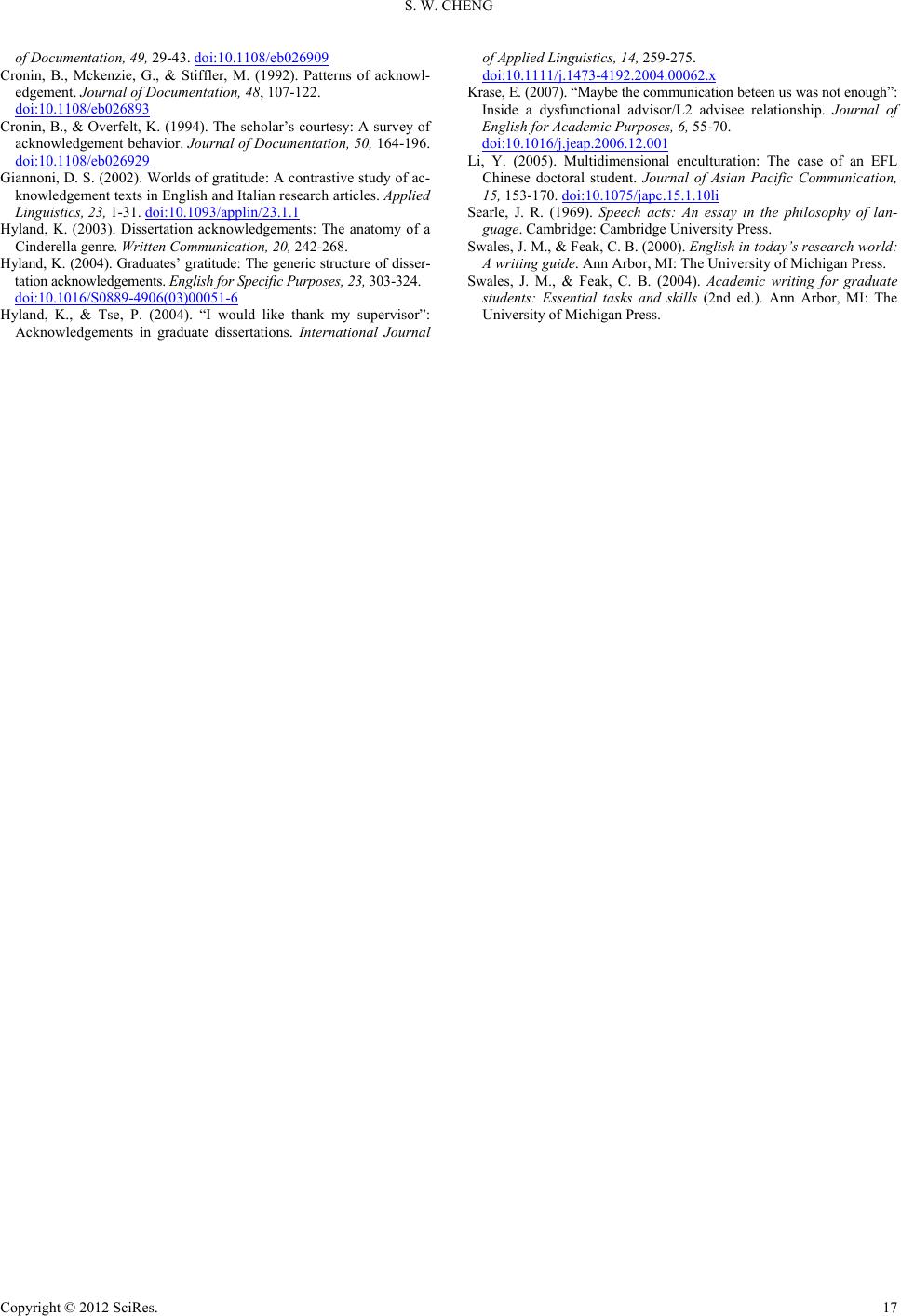 S. W. CHENG Copyright © 2012 SciRes. 17 of Documentation, 49, 29-43. doi:10.1108/eb026909 Cronin, B., Mckenzie, G., & Stiffler, M. (1992). Patterns of acknowl- edgement. Journal of Documentation, 48, 107-122. doi:10.1108/eb026893 Cronin, B., & Overfelt, K. (1994). The scholar’s courtesy: A survey of acknowledgement behavior. Journal of Documentation, 50, 164-196. doi:10.1108/eb026929 Giannoni, D. S. (2002). Worlds of gratitude: A contrastive study of ac- knowledgement texts in English and Italian research articles. Applied Linguistics, 23, 1-31. doi:10.1093/applin/23.1.1 Hyland, K. (2003). Dissertation acknowledgements: The anatomy of a Cinderella genre. Written Co mmu nication, 20, 242-268. Hyland, K. (2004). Graduates’ gratitude: The generic structure of disser- tation acknowledgements. English for Specific Purposes, 23, 303-324. doi:10.1016/S0889-4906(03)00051-6 Hyland, K., & Tse, P. (2004). “I would like thank my supervisor”: Acknowledgements in graduate dissertations. International Journal of Applied Linguistics, 14, 259-275. doi:10.1111/j.1473-4192.2004.00062.x Krase, E. (2007). “Maybe the co mmunication beteen us was not enough ”: Inside a dysfunctional advisor/L2 advisee relationship. Journal of English for Academic Purposes, 6, 55-70. doi:10.1016/j.jeap.2006.12.001 Li, Y. (2005). Multidimensional enculturation: The case of an EFL Chinese doctoral student. Journal of Asian Pacific Communication, 15, 153-170. doi:10.1075/japc.15.1.10li Searle, J. R. (1969). Speech acts: An essay in the philosophy of lan- guage. Cambridge: Cambridge University Press. Swales, J. M., & Feak, C. B. (2000). English in today’s research world: A writing guide. Ann Arbor, MI: The University of Michigan Press. Swales, J. M., & Feak, C. B. (2004). Academic writing for graduate students: Essential tasks and skills (2nd ed.). Ann Arbor, MI: The University of Michigan Press.
|